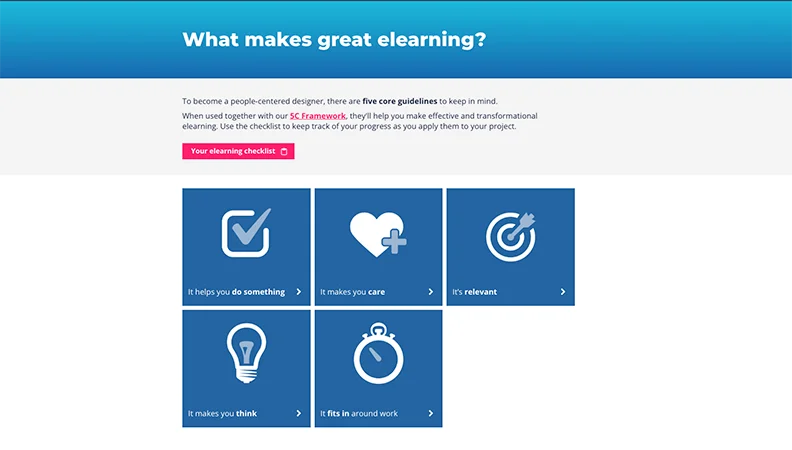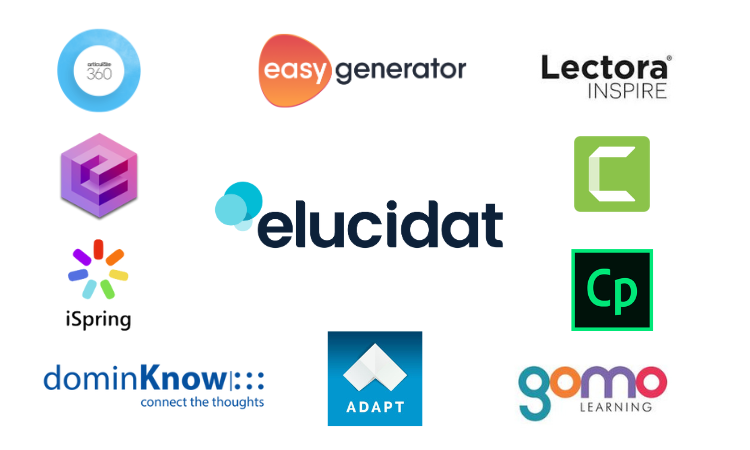7 must-knows for effective elearning
4 minute read
What does it take to create effective elearning that engages, vs online content that falls flat? Below, we distill the seven crucial ingredients shared in a recent webinar by Elucidat experts Will Brown and Kirstie Greany, that you need to produce elearning experiences that truly resonate and bring about meaningful change. Watch the webinar below to explore these insights in more depth.
The 7 must-know ingredients for effective elearning
1. Begin with the end in mind
Contrary to the instinct to start with content, it’s best to focus on the desired outcomes of your elearning. Understanding what you want your learners to achieve helps shape your content to be more than just information—it transforms it into a pathway for learning and development. This approach ensures your elearning is purposeful, targeted, and capable of driving the desired change.
2. Always tell stories
Stories are not just a means of illustrating points; they’re a fundamental way humans understand and remember information. Incorporating stories into your elearning can make complex concepts more relatable and memorable, encouraging learners to reflect and apply what they’ve learned.
The emotional connection and multiple perspectives offered by storytelling enhance engagement and retention. Stories can be written, visualized with imagery, or created as audio or video. They can even be a simple interview of someone who’s lived and breathed that topic.
Take a look at how this real-life story uses simple imagery and sound to bring it to life.

3. Let it breathe
Elearning effectiveness is often hampered by information overload. Space out content and activities. Breaking down your content into bite-sized, manageable pieces allows learners to absorb, practice, and reflect on information more effectively, leading to a more enriching learning experience. Sleeping on it actually helps too!
It’s also about spacing learning content out on a page. Use clear headings and subheadings to create sections and a flow on the page, and only put content together that belongs together!
See how this example uses clear headings to guide learners through the content, and avoid overwhelm.

Try this effective elearning example
4. Include practice activities
The essence of elearning is to bring about a change in behavior or enhance skill sets. Including practical activities and scenarios that reflect real-life challenges ensures that the learning is not only engaging but also directly applicable to the learner’s work or life context. Authentic, hands-on experiences are crucial for bridging the gap between knowledge and action.
Make sure your elearning has practice built in. That can be online exercises or offline.
This is one example of many from our Showcase, that introduces a scenario to give learners practice at answering a customers’ questions in some product training. Take a look!
Try this practical activity example
5. Create interactivity – Not just clicks
True interactivity engages the mind, not just the fingers. Effective elearning invites learners to think, reflect, and make decisions based on the content presented. This can be achieved through reflective questions, scenarios that require decision-making, and activities that stimulate critical thinking and problem-solving.
Do not skip this kind of interaction in your elearning – get those brains whirring!
Here is a simple example of how you can build in reflection. Create a short case study or story, and ask learners what they think. Do they agree? Would they have done the same? Is it fair?
6. Be relevant
Understanding your audience is key to creating relevant and effective elearning. Customizing content to fit the specific needs, roles, and contexts of your learners increases engagement and ensures that the learning experience is both meaningful and applicable. Personalization can range from role-based pathways to dynamic content that adjusts based on learner input.
It can also be about how you speak (or write) your content. Use the word ‘you’ to talk directly to the learner, and write the content like you are actually speaking with them.
Here’s an example of using a question as a ‘menu’ that links to the relevant content.
Try this effective elearning example
7. End with a bang
Finally, ending your elearning on a strong note is vital. Summarizing key points and providing clear next steps or actions ensures that the learning doesn’t end when the module does. This reinforcement helps solidify the learning and encourages immediate application, enhancing the overall impact of your elearning content.
Don’t leave your learners hanging. End with a call to action!
This example includes a simple Take it Further ending, with two options. What would yours be?
Try this effective elearning example
Dive deeper by watching the webinar
Interested in exploring these tips further? Watch the video recording of the webinar. These insights represent just the tip of the iceberg in creating effective elearning content.
Stay tuned for more Design Tip Tuesdays for continuous learning and improvement in your elearning design journey.




